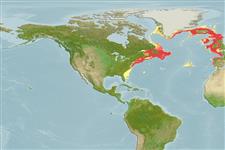Common names from other countries
Environment: milieu / climate zone / depth range / distribution range
Ekologi
Pelagis, permukaan; kisaran kedalaman 0 - 1000 m (Ref. 275). Tropical, preferred 21°C (Ref. 107945); 70°N - 26°N, 81°W - 2°W (Ref. 275)
Atlantic Ocean: British Isles north to Iceland and Greenland.
Length at first maturity / Size / Weight / umur
Maturity: Lm ? range ? - ? cm Max length : 27.0 cm ML jantan/; (Ref. 275); 31 cm ML (female)
Maximum mantle length is 31cm (females) and 27cm (males) in the northern part of its distributional range, but 20 cm (females) and 18cm (males) in the southern part (Ref. 3722). Feeds on euphausiids, capelin, herring, juvenile mackerel (Ref. 275).
Life cycle and mating behavior
Kematangan | Reproduksi, perkembang biakan | Pemijahan | telur-telur | Fecundity | Larva
Members of the class Cephalopoda are gonochoric. Male and female adults usually die shortly after spawning and brooding, respectively. Mating behavior: Males perform various displays to attract potential females for copulation. During copulation, male grasp the female and inserts the hectocotylus into the female's mantle cavity where fertilization usually occurs. Life cycle: Embryos hatch into planktonic stage and live for some time before they grow larger and take up a benthic existence as adults.
rujukan utama
Acuan | Koordinator | mitra
Roper, C.F.E., M.J. Sweeney and C.E. Nauen. 1984. (Ref. 275)
Status IUCN Red List (Ref. 130435)
status CITES (Ref. 108899)
Not Evaluated
Not Evaluated
penggunaan manusia
Perikanan: komersial
FAO - Perikanan: landings, profail spesis | FIRMS (Stock assessments) | FishSource | Sea Around Us
Alat, peralatan
Sumber internet
Estimates based on models
Preferred temperature
(Ref.
115969): 0.7 - 11.5, mean 6.4 (based on 424 cells).
Daya lenting
Tinggi, Waktu penggandaan populasi minimum kurang dari 15 bulan (K=0.3-2.5).
keancaman
Low vulnerability (23 of 100).
